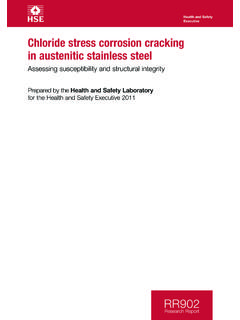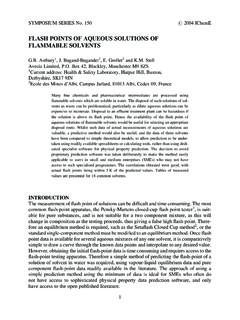Transcription of RR1170 - High Rise Residential Buildings: Preliminary ...
1 High Rise Residential Buildings: Preliminary Serious Incident Scenarios and Potential Control Measures Prepared by researchers at: The Health and Safety Executive and Ove Arup & Partners Ltd RR1170 (2021) Research Report 2 Crown copyright 2021 Prepared 2019 First published 2021 You may reuse this information (not including logos) free of charge in any format or medium, under the terms of the Open Government Licence. To view the licence: visit the National Archives Website, write to the Information Policy Team, The National Archives, Kew, London TW9 4DU, or email Some images and illustrations may not be owned by the Crown so cannot be reproduced without permission of the copyright owner.
2 Enquiries should be sent to The Grenfell Tower disaster, 14 June 2017, killed 72 people and injured more than 70 others. The subsequent Independent Review of Building Regulations and Fire Safety concluded that the UK building safety system is inadequate. The Government accepted the review s recommendation for a new regulatory framework. A Joint Regulators Group, including the Health and Safety Executive, is assisting in the transition to this proposed framework. This report describes research, done in 2019, for the Joint Regulators Group. The research aims to identify a Preliminary set of representative serious incident scenarios for high rise Residential buildings, and potential control measures.
3 The researchers: reviewed the literature on high rise building incidents, and the regulation of major rail and industrial incidents; and conducted workshops to extract critical knowledge from sector representatives. The research team has experience in safety case regimes, risk management, building construction, and fire. They used formal risk analysis techniques ( HAZID and bow tie ) to structure the process, and a Hierarchy of Controls approach to rank the effectiveness of potential control measures. They considered rapidly escalating events requiring immediate large scale emergency response.
4 The report identifies ten Preliminary representative serious incident scenarios. The potential control measures identified for consideration include: establishing a safety regime based on assessment of serious incident scenarios; development of an initial safety narrative for each building; near-miss incident recording; guidance for duty holders; and strong and committed leadership from dutyholders, the wider sector, and the future regulator. These findings are being used to inform the development of a risk framework for the proposed new safety case regime.
5 This report and the work it describes was funded by the Ministry of Housing, Communities and Local Government (MHCLG), now the Department for Levelling Up, Housing and Communities (DLUHC). Its contents, including any opinions and/or conclusions expressed, are those of the authors alone and do not necessarily reflect HSE policy. 3 High Rise Residential Buildings: Preliminary Serious Incident Scenarios and Potential Control Measures Richard Bettis*, Zoe Chaplin, Ed Corbett*, Gary Dobbin, Maria Garcia, Nicola Healey, Chrysanthi Lekka, Ron Macbeth*, Nic Rigby, Mike Wardman*, Jill Wilday and Louisa Wood Health and Safety Executive Harpur Hill, Buxton, Derbyshire, sk17 9JN Ishan Abeysekera and David Cormie ARUP Ove Arup and Partners Ltd, 13 Fitzroy Street, London.
6 W1T 4BQ *Lead authors 4 Acknowledgements The research project team wish to pass on a sincere thanks to all those sector representatives who gave up their time to support the project, particularly those who attended the workshop sessions. Without the time and engagement of these individuals, this work would not have been possible. 5 Key messages Following the Grenfell disaster, the Independent Review of Building Regulations Fire Safety recommended a new regulatory framework for building safety in the UK. This research report describes work done for the Joint Regulators Group, which was set up to assist in the transition to this proposed framework.
7 The research aims to identify a Preliminary set of serious incident scenarios for high rise Residential buildings, and potential control measures. For high rise Residential buildings, a serious incident scenario might be considered an escalation of a rapid onset event that could adversely affect the health and safety of people and nearby infrastructure from: fire, explosion, and structural damage. Significant incident scenarios have been developed taking into account information obtained during workshops with sector representatives. The scenarios consider rapid escalation events that could lead to major consequences, usually requiring immediate and significant emergency response.
8 Key areas for consideration from the identification of these scenarios include: Fires in a flat/unit in a high rise Residential building Fires on a balcony Maintaining escape routes Dealing with unmanaged changes Addressing issues at the design phase is more effective in many cases The importance of monitoring and maintenance Use of multiple independent risk controls (layers of protection) for adequate resilience The work has outlined that a safety case regime would be possible for high rise Residential buildings but would bring a number of challenges that would need to be overcome.
9 Outcomes identified for consideration include: A safety regime for high rise Residential buildings could be established based on an assessment of significant incident scenarios within the building, clearly identifying how they are prevented from turning into significant incidents. An initial safety narrative could be developed for each building as a starting point to aid dutyholders in identifying reasonably practicable risk controls and to allow the sector to become familiar with managing significant incident risks. Near-miss incident recording could be included as part of the safety narrative process to develop understanding of what works and when it works.
10 Guidance could be developed to help dutyholders understand how to assess and manage significant incident risks associated with buildings in scope, and how they can disseminate the necessary safety information in an appropriate format. The need for strong and committed leadership from dutyholders, the wider sector, and from the regulator. 6 Executive summary Following the Grenfell disaster, the Independent Review of Building Regulations Fire Safety recommended a new regulatory framework for building safety in the UK. This research report describes work done for the Joint Regulators Group, which was set up to assist in the transition to this proposed framework.












